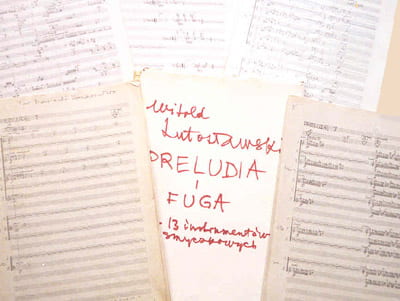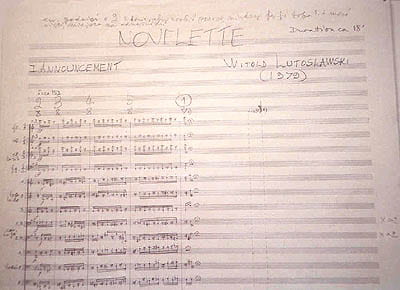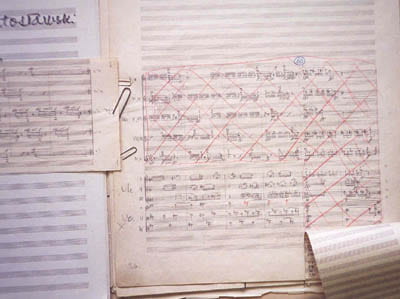25 January 1913, Warsaw – 7 February 1994, Warsaw
Biography
Witold Lutosławski—one of the greatest musicians of the twentieth century—began to study violin in Warsaw in 1926 and, a year later, as a part-time student he entered the Warsaw Conservatory where Karol Szymanowski was both professor and director. In 1931 he enrolled to study mathematics at the Warsaw University. Simultaneously, he pursued composition with Witold Maliszewski (a pupil of Nikolai Rimsky-Korsakov) and piano with Jerzy Lefeld. By 1937—the year Lutosławski graduated from the Conservatory—he was already known as a virtuoso pianist and a promising young composer. During the years of World War II, Lutosławski was forced to make a living by playing original compositions, transcriptions, as well as popular music in Warsaw cafes, together with his colleague Andrzej Panufnik. His Paganini Variations for Two Pianos (1941) is practically the only work from that era that was ever published.
After the war, the Stalinist regime criticized Lutosławski’s First Symphony (1941-1947) as “formalist.” Undaunted, he forged ahead with a string of significant compositions, including Little Suite for Orchestra (1951), Concerto for Orchestra (1954) and the Dance Preludes for clarinet and piano (1954). One of the masterpieces that emerged after the political “thaw” of 1956 was his Musique funèbre (1958), written in memory of Bartók, a work that finally established Lutosławski’s international reputation. His unique application of the aleatoric technique, which gives the performers creative freedom within specific musical parameters, was first used in Jeux venitiens (1961) for chamber orchestra and, since then has been employed in most of his subsequent compositions.
Lutosławski was a master of the orchestral medium, producing a number of beautifully crafted and imaginatively orchestrated large scale works. His sense of orchestral color is similar to that of Debussy or Ravel whilst his keen sense of form shows much kinship with Bartók’s methods of organizing the musical material. Among the milestones in Lutosławski’s legacy are his last three symphonies (dating from 1967, 1983, and 1993), the Cello Concerto (written for Rostropovich in 1970), his Oboe and Harp Concerto (1980), the vocal-orchestral settings of French verse (Three Poems of Henri Michaux, 1963, Paroles tissées, 1965, and Les espaces du sommeil, 1975), and the Piano Concerto (1988).
Throughout his life, Lutosławski was a frequent guest conductor and lecturer all over the globe. He also received numerous international prizes, including the UNESCO Prize (in 1959 and 1968), the French Order of Commandeur des Arts et des Lettres (1982), the Grawemeyer Award (1985), the Royal Philharmonic Society Gold Medal (1986), and the Inamori Foundation Prize for his outstanding contribution to contemporary European music. Lutosławski’s Fourth Symphony was also posthumously recognized with the International Music Award for best large-scale composition.
The Polish Music Center at USC owns six original manuscripts of Lutosławski’s orchestral works: Mini Overture, Preludes and Fugue for 13 strings, Mi-Parti for orchestra, Novelette for orchestra, and Paroles tissées for tenor and orchestra. These were personally donated by the composer during his visit to Los Angeles in 1985, when he was present for the dedication of the Polish Music Center.
Selected Compositions
For List of Works, click here.
For Bibliography, click here.
For Discography, click here.
Requiem fragments for soprano, choir, orchestra (1937)
Lacrimosa for soprano and organ (1937)
Symphonic Variations for orchestra (1938)
Two Studies for piano (1941)
Variations on a Theme by Paganini for two pianos (1941)
Variations on a Theme by Paganini for piano and orchestra (1941/1978)
Symphony No. 1 (1947)
Overture for strings (1949)
Little Suite for chamber ensemble (1950)
Little Suite for orchestra (1950/1951)
Silesian Triptych for soprano and orchestra (1951)
Recitative e arioso for violin and piano (1951)
Bucolics for piano (1952)
Bucolics for violin and cello (1952/1962)
Miniature for two pianos (1953)
Three Fragments for flute and harp (1953)
Concerto for Orchestra (1954)
Dance Preludes for clarinet and piano (1954)
Dance Preludes for clarinet and chamber orchestra (1954/1955)
Dance Preludes for chamber ensemble (1954/1959)
Five Songs for soprano and piano (1957)
Five Songs for soprano and orchestra (1957/1958)
Musique funèbre for string orchestra (1958)
Three Postludes for orchestra (1960)
Jeux vénitiens for chamber orchestra (1961)
Trois poemes d’Henri Michaux for choir and orchestra (1963)
Quartet for Strings (1964)
Paroles tissées for tenor and chamber orchestra (1965)
Symphony No. 2 (1967)
Livre pour orchestre (1968)
Invention for piano (1968)
Concerto for Cello and Orchestra (1970)
Preludes and Fugue for 13 strings (1972)
Les espaces du sommeil for baritone and orchestra (1975)
Sacher Variation for cello (1975)
Mi-parti for orchestra (1976)
Novelette for orchestra (1979)
Epitaph for oboe and piano (1979)
Double Concerto for oboe, harp and chamber orchestra (1980)
Grave: Metamorphoses for cello and piano (1981)
Grave: Metamorphoses for cello and string orchestra (1981)
Nie dla ciebie for soprano and piano (1981)
Mini-Overture for brass quintet (1982)
Symphony No. 3 (1983)
Chain I for instrumental ensemble (1983)
Partita for violin and piano (1984)
Partita for violin and orchestra (1984/1988)
Chain II: Dialogue for violin and orchestra (1985)
Chain III for orchestra (1985)
Fanfare for Louisville for winds and percussion (1986)
Fanfare for CUBE for brass quintet (1987)
Concerto for Piano and Orchestra (1987)
Slides for chamber ensemble (1988)
Prelude for G.S.M.D. for orchestra (1989)
Fanfare for Lancaster for brass ensemble and side drum (1989)
Interlude for orchestra (1989)
Tarantella for baritone and piano (1990)
Chantefleurs et Chantefables for soprano and orchestra (1990)
Symphony No. 4 (1992)
Subito for violin and piano (1992)
Fanfare for LA Phil for brass and percussion (1993)
“Music is an art taking place within a time. That’s why, among other things, we compose it to evoke in the listener a chain of certain reactions whose order and sequence in time possess the basic meaning for a desired result that is the perception of the entirety of the work. In other words, as we create a certain closed form, we conclude that during performance the listener is kind of led by the composer through the various stages of the composition until its end. […] Haydn was a master of ordering the musical substance in time…”
[From an interview with Ludwik Gawroński: Muzyka w Programie Drugim Polskiego Radia. “Akcent” No. 3 (101), 2005]
Manuscripts at USC

In January 1985, on the occasion of the dedication of the Polish Music Reference Center (now: Polish Music Center), within the Music Library of the University of Southern California, Witold Lutosławski donated five complete manuscripts of the final versions of his compositions. The ceremony was held at the Music Library in Doheny Library at USC, in the presence of the composer, officials from USC (including the Dean of the School of Music, William Thomson, and the Dean of the Libraries, Dr. Robertston), founders of the Center, Dr. And Mrs. Wilk, invited guests and the press.
The Lutoslawski holdings of the PMC were increased in May 2001, thanks to a donation of the composer’s copy with manuscript title pages and notes of Trois poèmes d’Henri Michaux, given by Józef Patkowski. The Lutosławski manuscripts are on deposit in the Special Collections Department of the Doheny Library at USC and may be viewed in the reading room of the Library. All study and research requests should be directed to the Special Collections Department at USC.
Mini-uwertura [Mini Overture]. 1982. Manuscript score: 3 bi-folios, 11 pages, including cover page in ink and the music pages in pencil. On 20-stave B&H musci paper with logo.
Preludia i fuga na 13 instrumentów smyczkowych [Preludes and Fugue for 13 strings]. 1970-1972. Completion date 29 June 1972. Manuscript score of over 150 pages, with a cardboard cover and title handwritten by the composer, the score in pencil with annotations in red and blue. 20-stave Dom Książki paper. Seven preludes and fugue: Prelude 1 (10 pages dedicated to Mario D. Bonaventura), Prelude 2 (8 pages), Prelude 3 (12 pages), Prelude 4 (12 pages), Prelude 5 (7 pages), Prelude 6 (14 pages), Prelude 7 (14 Pages), Fugue (74 pages).

Mi-Parti for orchestra. Completion date 15 June 1976. Manuscript score of 43 pages, individual sheets, written on one side in pencil, with marginal marks (X) to show annotations and changes and inserts attached with paper clips to cover crossed off sections. On Panopus Score system made in England C30, L45 paper.
Novelette for orchestra. 1979. Manuscript score of 46 pages, individual sheets, written on one side in pencil, with pencil annotations and taped inserts correcting sections with corrections in red. On Panopus Score system made in England C30, L36, L40, L 45 paper.

Paroles tissées for tenor and orchestra. 1965. Completion date 10 May 1965. 12 bi-folios, 48 pages, in pencil with blue and red pencil annotations, title page in black marker. Pages 24-25 contain inserts attached with a paperclip over a crossed-out section of the score. 32-stave PWM music paper. Paper in poor condition.

Trois poèmes d’Henri Michaux: partition d’orchestre. [Three Poems by Henry Michaux: orchestral score]. Orchestral score of work for double chorus and orchestra. 45 pages, blue print copy from the composer’s mansucript, with a handmade cover, title page signed by the composer who wrote the title in large letters. Oversized.
Trois poèmes d’Henri Michaux: partition de choeur. [Three Poems by Henry Michaux: chorus score]. Choral score of work for double chorus and orchestra. 45 pages, blue print copy from the composer’s mansucript, with a handmade cover, title page signed by the composer who wrote the title in large letters. Oversized.
Links
Page updated on 9 April 2018
